Global Waste Index 2022
Global Waste Index 2022: These are the biggest waste producers in the world
With the Global Waste Index, we at Sensoneo first exposed the biggest waste-producing nations in the world in 2019. At the time, Turkey, Latvia, and New Zealand landed in the less-than-glorious top spots of nations with the worst waste management. The United States emerged as the largest waste producer per capita, and the UK was placed in the 20th slot out of 36 nations surveyed. More on the 2019 Global Waste Index can be found here.
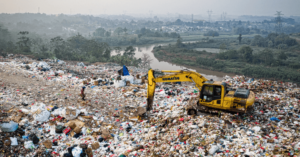
Three years and one pandemic later, we have updated the Global Waste Index with the latest data. The pandemic in particular has created large volumes of disposable products, such as medical masks and Covid rapid tests, causing a strain on waste systems around the world. This study takes another look at the amount of waste generated, recycling rates and other disposal methods, such as incineration and landfilling, as well as the consequences of mismanagement, such as illegal waste disposal (all figures in kg per inhabitant). The result is the following Global Waste Index 2022.
Countries in Global Waste Index 2022 are sorted in a descending order, beginning with the best rated nations coming down to the biggest waste-producing nations in the world.
The appealling waste balance
After a comprehensive analysis of waste management in 38 countries, Turkey repeatedly emerges as the largest waste-producing nation in the world. While recycling was not yet a part of Turkey’s waste management in 2019, three years later the country is now recycling 47 kilograms of waste per capita. However, the welcome efforts can’t hide the high volume of waste that is disposed of illegally. A total of 176 kilograms of waste per capita is disposed of in an uncontrolled manner in Turkey.
Despite numerous efforts against single-use plastic items (for example, the EU single-use plastic ban), the Corona pandemic has made new disposable items, such as medical masks and Covid rapid tests, indispensable. The United States generates the largest amount of private waste: 811 kilograms per capita.
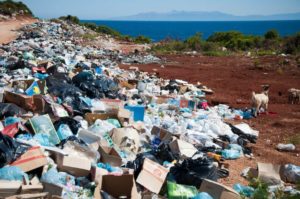
From an environmental perspective, waste incineration is preferable to landfill. Only 17 of the 38 countries in the report incinerate more than they landfill. They are Austria, Belgium, Denmark, Estonia, Finland, France, Germany, Ireland, Japan, Luxembourg, the Netherlands, Norway, Slovenia, South Korea, Sweden, Switzerland, and the United Kingdom.
The UK has actually improved its ranking from 2019 to 2022 – moving away from the positions of biggest waste producers – from 20th to 18th place. This is because it is producing less waste (468kg per capita in 2019, compared to 463kg per capita in 2022). Also less waste is ending up in landfills. In 2019, 109kg per capita of waste in the United Kingdom was sent to landfills, and in 2022 that reduced to 69kg per capita. Meanwhile, more waste is being incinerated – 190kg per capita was burned according to the Global Waste Index in 2022, compared to 152kg in 2019.
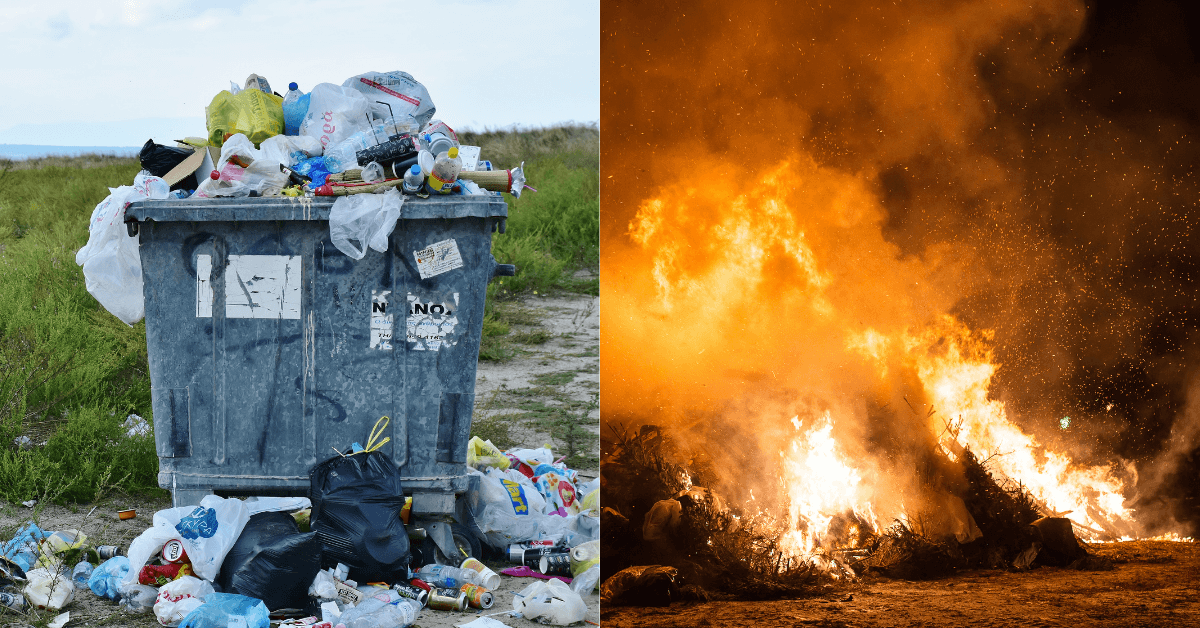
The great recycling myth
Many countries like to boast about their progressive waste management and high recycling rates. Sweden, South Korea and Germany are among them, and Germany is often celebrated as a world champion for recycling.
However, the high recycling rates for plastic waste could be misleading. This number is taken from the volume of waste that arrives at the recycling plants, but not everything is actually recycled. This number is the amount of waste at the beginning of the lengthy sorting process, at the end only a fraction of that waste is actually reused. What remains is incinerated.
Read more about the “Great Recyling Myth” here.
Environmental organizations such as the Friends of the Earth Germany estimate that less than 16% of the recyclable waste earmarked for recycling in Germany can actually be reused. The biggest problem is caused by mixtures of recyclable materials in items such as a yogurt pot with a cardboard sleeve and aluminum lid. If these are not separated before arrival, there is a high probability it will be registered at the recycling plant but will still end up being incinerated. Small, very thin materials and some food packaging are difficult to recycle, as their reprocessing needs sophisticated technologies that are not easily available. Their usability on the market and the price of the recycled materials also reflect on the recycling process.
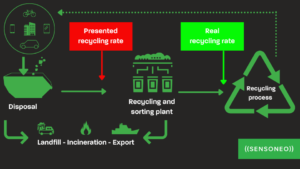
With this year’s new edition of the Global Waste Index, we at Sensoneo want to draw attention to the enormous waste problem in the world. This re-evaluation with the latest data allows us to compare waste volumes and waste management methods in 2019 and 2022. When it comes to potentially embellished recycling rates – not just in Germany – we want to emphasize that the Global Waste Index is only an indicator for the largest waste producers in the world. A good score in the index does not mean that a country’s waste management does not need improvement. The overriding goal has to be to produce as little waste as possible.
To ensure the waste is managed as efficiently as possible, it is important that each company, public entities, and individuals approach this matter responsibly and contribute to the improvement with his own piece. At Sensoneo, we focus on the development of solutions that digitally transform waste management to ensure easy traceability, data reliability and accuracy, and operations efficiency.
Methodology
The Global Waste Index 2022 is a comparative analysis of waste management in the 38 member states of the Organization for Economic Cooperation and Development (OECD). The Global Waste Index was first compiled in 2019 and for this reason also allows for a comparison of global waste disposal in 2019 and 2022. There was no new data available for the United States, so the latest available statistics from three years ago were used for this index. The countries of Colombia and Costa Rica have only been member states of the OECD since 2020 and 2021, respectively, and for this reason are missing from the 2019 World Waste Index.
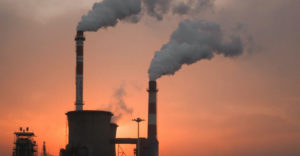
The following six factors were examined
Data from the following sources was used to calculate the ranking. Only disposal methods that could guarantee data for all countries were selected. Among other things, the composting of organic waste is missing. For this reason, in some cases, the amounts of the following disposal methods do not add up to the mass of municipal waste. Only the most recent data available was ever used (as of 04.01.2022):
Waste generated: Mass in kilograms per inhabitant and year
Recycling: Mass in kilograms per inhabitant and year that is declared to become new raw materials
Waste incineration: Mass in kilograms per inhabitant and year that is incinerated in a controlled manner
Landfill: Mass in kilograms per inhabitant per year that is landfilled in a controlled and uncontrolled manner
Illegal waste disposal: Mass in kilograms per inhabitant per year of waste disposed of illegally
Other waste: Mass in kilograms per inhabitant per year that is generated without being recorded
Sources:
1. Eurostat “Municipal waste by waste management operations”:
EU data set on municipal waste referring to 2020.
2. OECD data “Municipal waste”:
OECD data set on municipal waste referring to 2019 in most cases. The data from the municipal waste in the USA dates back from 2018. For all other cases, the latest available data was used. This included, among other things, information about municipal solid waste in the USA, which dates back to 2018.
3. World Bank “What a waste”:
Global waste management dataset, referring to different years depending on the state. In each case, the most recent data available was used.
Calculation of the ranking/scoring
In order to rank the countries in terms of waste management, a positive or negative score was assigned to each of the above factors. This was derived from the overall environmental impact (level of CO2 emissions) resulting from each disposal method.
Municipal waste: Environmentally harmful, the higher the mass per inhabitant, the more points (0 to 5) were subtracted
Recycling: Environmentally friendly, the higher the mass per inhabitant, the more points (0 to 6.6) were added
Waste incineration: Relatively environmentally friendly, the higher the mass per inhabitant, the more points (0 to 1.6) were added
Landfill: Polluting, the higher the mass per inhabitant, the more points (0 to 5) were subtracted
Illegal waste disposal: Extremely polluting, the higher the mass per inhabitant, the more points (0 to 10) were subtracted
Other wastes: Extremely polluting, the higher the mass per inhabitant, the more points (0 to 10) were subtracted
Final evaluation
All resulting scores were standardized from 0 to 10 for better comparability and added together. The total was then standardized on a scale of 0-100. The country with the lowest score overall received a score of 0, and represents the country whose waste management has the greatest impact on the environment. The country with the highest score got a score of 100 and represents the country whose waste management impacts the environment the least. All other countries were ranked between 0-100 according to their evaluation score. This results in the ranking of the Global Waste Index 2022.
About Sensoneo
Sensoneo provides smart enterprise-grade waste management solutions for cities, businesses and countries to cost-efficiently manage the waste lifecycle and improve the environment and well-being of people. Through its unique smart waste management technology, Sensoneo is redefining the way waste is managed. Through its unique smart waste management technology, Sensoneo helps to cope with the biggest challenges in today’s world of waste management – increasing waste production and lack of efficiency and transparency.
Discover our case studies
-
Monitoring street containers in the capital of Iceland, Reykjavík
Iceland - Street containers Type of monitoring
- NB-IoT & LoRaWAN Connectivity
-
One of the largest smart waste deployments in South America in Buenos Aires
- 4500 Number of sensors
- General Type of waste
- NB-IoT & LoRaWAN Connectivity
-
Real-time data on the fill levels of semi-underground bins in Patras Open Mall project in Greece
Greece - 126 Number of containers
- Different streams Type of waste
- Semi-underground Type of bins
-
School District is monitoring dumpsters to optimize waste collection in Ohio, USA
Ohio, USA - > 12 000 Students
- Narrowband IoT Network
-
Smart technology for textile waste collector in CEE
Bulgaria, Romania and Greece - 400 Number of containers
- Textile Waste Type of monitoring
- 3.500 tons Volumes collected annually
-
Smart waste management for tractor factory in Germany
Germany - 400 Number of containers
- Factory waste Type of monitoring
- Sigfox 0G network Connectivity



